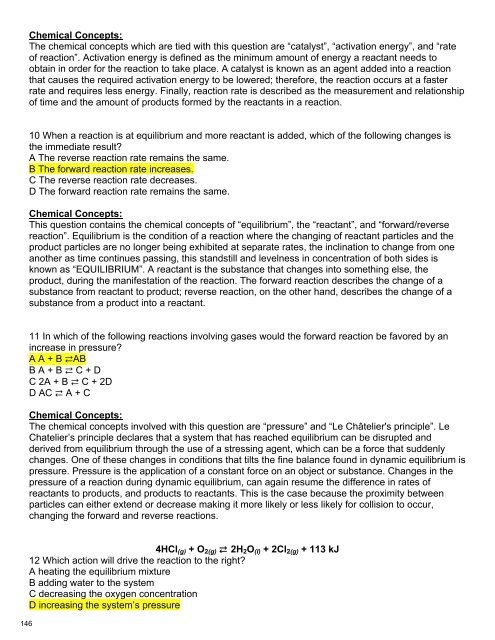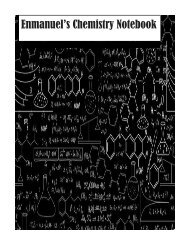You also want an ePaper? Increase the reach of your titles
YUMPU automatically turns print PDFs into web optimized ePapers that Google loves.
<strong>Chem</strong>ical Concepts:<br />
The chemical concepts which are tied with this question are “catalyst”, “activation energy”, and “rate<br />
of reaction”. Activation energy is defined as the minimum amount of energy a reactant needs to<br />
obtain in order for the reaction to take place. A catalyst is known as an agent added into a reaction<br />
that causes the required activation energy to be lowered; therefore, the reaction occurs at a faster<br />
rate and requires less energy. Finally, reaction rate is described as the measurement and relationship<br />
of time and the amount of products formed by the reactants in a reaction.<br />
10 When a reaction is at equilibrium and more reactant is added, which of the following changes is<br />
the immediate result?<br />
A The reverse reaction rate remains the same.<br />
B The forward reaction rate increases.<br />
C The reverse reaction rate decreases.<br />
D The forward reaction rate remains the same.<br />
<strong>Chem</strong>ical Concepts:<br />
This question contains the chemical concepts of “equilibrium”, the “reactant”, and “forward/reverse<br />
reaction”. Equilibrium is the condition of a reaction where the changing of reactant particles and the<br />
product particles are no longer being exhibited at separate rates, the inclination to change from one<br />
another as time continues passing, this standstill and levelness in concentration of both sides is<br />
known as “EQUILIBRIUM”. A reactant is the substance that changes into something else, the<br />
product, during the manifestation of the reaction. The forward reaction describes the change of a<br />
substance from reactant to product; reverse reaction, on the other hand, describes the change of a<br />
substance from a product into a reactant.<br />
11 In which of the following reactions involving gases would the forward reaction be favored by an<br />
increase in pressure?<br />
A A + B ⇄AB<br />
B A + B ⇄ C + D<br />
C 2A + B ⇄ C + 2D<br />
D AC ⇄ A + C<br />
<strong>Chem</strong>ical Concepts:<br />
The chemical concepts involved with this question are “pressure” and “Le Châtelier's principle”. Le<br />
Chatelier’s principle declares that a system that has reached equilibrium can be disrupted and<br />
derived from equilibrium through the use of a stressing agent, which can be a force that suddenly<br />
changes. One of these changes in conditions that tilts the fine balance found in dynamic equilibrium is<br />
pressure. Pressure is the application of a constant force on an object or substance. Changes in the<br />
pressure of a reaction during dynamic equilibrium, can again resume the difference in rates of<br />
reactants to products, and products to reactants. This is the case because the proximity between<br />
particles can either extend or decrease making it more likely or less likely for collision to occur,<br />
changing the forward and reverse reactions.<br />
4HCl (g) + O 2(g) ⇄ 2H 2 O (l) + 2Cl 2(g) + 113 kJ<br />
12 Which action will drive the reaction to the right?<br />
A heating the equilibrium mixture<br />
B adding water to the system<br />
C decreasing the oxygen concentration<br />
D increasing the system’s pressure




